Stock-market:
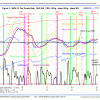 ECRI reported the WLI at a level of 128.3 and the six months smoothed annualized growth WLIg at +5.1%, both figures up from last week, as shown in Fig 2. Eight weeks ago the IBH model generated a sell-basic signal and 2 days later a sell A signal, indicating that the model had exited the S&P500. So far the S&P has gained since the sell signal. Clearly the sell A signal came to early. As many of you know, I have been struggling to find a good indicator for the sell A signal.
ECRI reported the WLI at a level of 128.3 and the six months smoothed annualized growth WLIg at +5.1%, both figures up from last week, as shown in Fig 2. Eight weeks ago the IBH model generated a sell-basic signal and 2 days later a sell A signal, indicating that the model had exited the S&P500. So far the S&P has gained since the sell signal. Clearly the sell A signal came to early. As many of you know, I have been struggling to find a good indicator for the sell A signal.
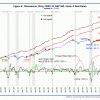 Now, based on a suggestion by one of our readers, I found that using a commodity channel index provided good exit signals after a sell basic signal and lifted the long-term rates of return by almost 0.5%, as shown in figure 6. Here are the new rules for a sell A signal:
Now, based on a suggestion by one of our readers, I found that using a commodity channel index provided good exit signals after a sell basic signal and lifted the long-term rates of return by almost 0.5%, as shown in figure 6. Here are the new rules for a sell A signal:
A Type A sell signal is generated after a basic sell signal :
- when for the first time after a basic sell signal, the day after the oscillator level derived from a 30-day Commodity Channel Index (CCI) calculation for the S&P500, scaled with an inverse factor of 0.015, exceeded 100 for 3 days in succession, but not later than 65 days.
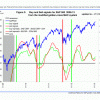 MAC Fig 3 shows the spreads of the moving averages. The sell spread (red graph) has now formed a trough and a sell signal will not be generated in the near future. The model stays invested.
MAC Fig 3 shows the spreads of the moving averages. The sell spread (red graph) has now formed a trough and a sell signal will not be generated in the near future. The model stays invested.
Bond-market:
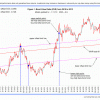 The Bond Value Ratio is shown in Fig 1. The BVR has been declining since August 2012 and long bonds with them. The trend appears to be downwards. In the longer term BVR will reach the long-term trendline and long-bond investors will have suffered considerable losses by then. The model stays invested in low beta bonds.
The Bond Value Ratio is shown in Fig 1. The BVR has been declining since August 2012 and long bonds with them. The trend appears to be downwards. In the longer term BVR will reach the long-term trendline and long-bond investors will have suffered considerable losses by then. The model stays invested in low beta bonds.
The Yield Curve:
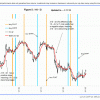 Figure 5 charts (i10 – i2). The trend is up now – the model expects the yield curve to steepen, bad news for long bond investors. FLAT and STPP are ETNs. STPP profits from a steepening yield curve and FLAT increases in value when the yield curve flattens.
Figure 5 charts (i10 – i2). The trend is up now – the model expects the yield curve to steepen, bad news for long bond investors. FLAT and STPP are ETNs. STPP profits from a steepening yield curve and FLAT increases in value when the yield curve flattens.
Recession:
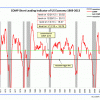 Attached is the updated COMP which declined a bit further since last week and has rolled over. This indicator is far away from a recession signal.
Attached is the updated COMP which declined a bit further since last week and has rolled over. This indicator is far away from a recession signal.
Gold:
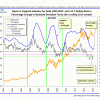 The updated Coppock indicator for gold is shown in figure 4. It has not formed a trough yet, but the year-over-year rolling return percentage change expressed in standard deviation terms seems to indicate an oversold condition. See my article at dshort Is it Time to Buy Gold Again?
The updated Coppock indicator for gold is shown in figure 4. It has not formed a trough yet, but the year-over-year rolling return percentage change expressed in standard deviation terms seems to indicate an oversold condition. See my article at dshort Is it Time to Buy Gold Again?
